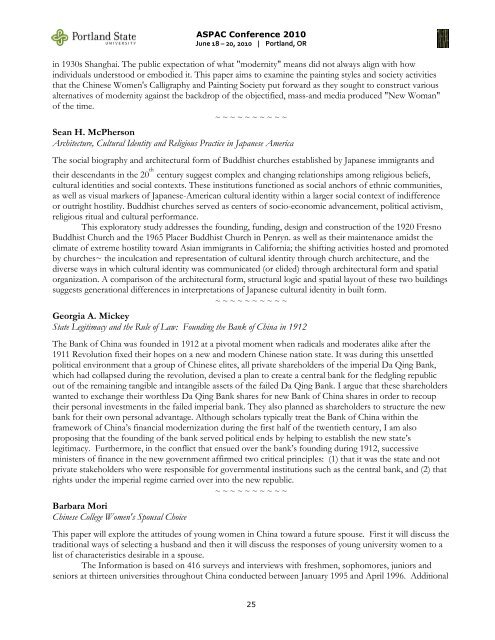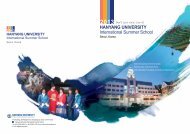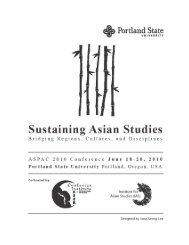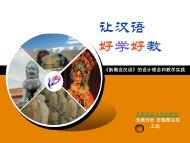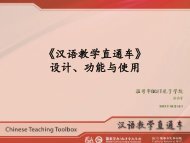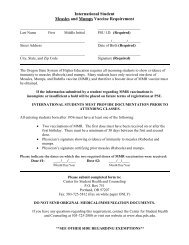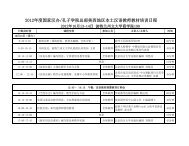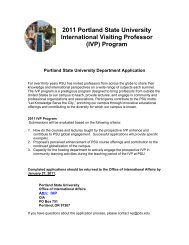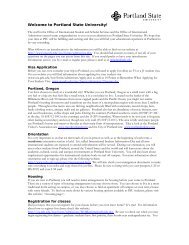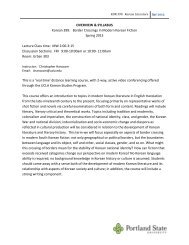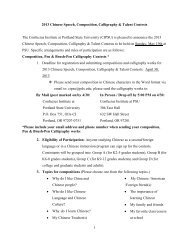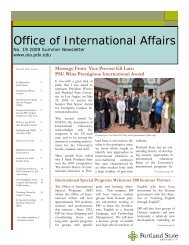ABSTRACTS - oia - Portland State University
ABSTRACTS - oia - Portland State University
ABSTRACTS - oia - Portland State University
Create successful ePaper yourself
Turn your PDF publications into a flip-book with our unique Google optimized e-Paper software.
ASPAC Conference 2010<br />
June 18 – 20, 2010 | <strong>Portland</strong>, OR<br />
in 1930s Shanghai. The public expectation of what "modernity" means did not always align with how<br />
individuals understood or embodied it. This paper aims to examine the painting styles and society activities<br />
that the Chinese Women's Calligraphy and Painting Society put forward as they sought to construct various<br />
alternatives of modernity against the backdrop of the objectified, mass-and media produced "New Woman"<br />
of the time.<br />
~ ~ ~ ~ ~ ~ ~ ~ ~ ~<br />
Sean H. McPherson<br />
Architecture, Cultural Identity and Religious Practice in Japanese America<br />
The social biography and architectural form of Buddhist churches established by Japanese immigrants and<br />
their descendants in the 20 th century suggest complex and changing relationships among religious beliefs,<br />
cultural identities and social contexts. These institutions functioned as social anchors of ethnic communities,<br />
as well as visual markers of Japanese-American cultural identity within a larger social context of indifference<br />
or outright hostility. Buddhist churches served as centers of socio-economic advancement, political activism,<br />
religious ritual and cultural performance.<br />
This exploratory study addresses the founding, funding, design and construction of the 1920 Fresno<br />
Buddhist Church and the 1965 Placer Buddhist Church in Penryn. as well as their maintenance amidst the<br />
climate of extreme hostility toward Asian immigrants in California; the shifting activities hosted and promoted<br />
by churches~ the inculcation and representation of cultural identity through church architecture, and the<br />
diverse ways in which cultural identity was communicated (or elided) through architectural form and spatial<br />
organization. A comparison of the architectural form, structural logic and spatial layout of these two buildings<br />
suggests generational differences in interpretations of Japanese cultural identity in built form.<br />
~ ~ ~ ~ ~ ~ ~ ~ ~ ~<br />
Georgia A. Mickey<br />
<strong>State</strong> Legitimacy and the Rule of Law: Founding the Bank of China in 1912<br />
The Bank of China was founded in 1912 at a pivotal moment when radicals and moderates alike after the<br />
1911 Revolution fixed their hopes on a new and modern Chinese nation state. It was during this unsettled<br />
political environment that a group of Chinese elites, all private shareholders of the imperial Da Qing Bank,<br />
which had collapsed during the revolution, devised a plan to create a central bank for the fledgling republic<br />
out of the remaining tangible and intangible assets of the failed Da Qing Bank. I argue that these shareholders<br />
wanted to exchange their worthless Da Qing Bank shares for new Bank of China shares in order to recoup<br />
their personal investments in the failed imperial bank. They also planned as shareholders to structure the new<br />
bank for their own personal advantage. Although scholars typically treat the Bank of China within the<br />
framework of China’s financial modernization during the first half of the twentieth century, I am also<br />
proposing that the founding of the bank served political ends by helping to establish the new state’s<br />
legitimacy. Furthermore, in the conflict that ensued over the bank’s founding during 1912, successive<br />
ministers of finance in the new government affirmed two critical principles: (1) that it was the state and not<br />
private stakeholders who were responsible for governmental institutions such as the central bank, and (2) that<br />
rights under the imperial regime carried over into the new republic.<br />
~ ~ ~ ~ ~ ~ ~ ~ ~ ~<br />
Barbara Mori<br />
Chinese College Women's Spousal Choice<br />
This paper will explore the attitudes of young women in China toward a future spouse. First it will discuss the<br />
traditional ways of selecting a husband and then it will discuss the responses of young university women to a<br />
list of characteristics desirable in a spouse.<br />
The Information is based on 416 surveys and interviews with freshmen, sophomores, juniors and<br />
seniors at thirteen universities throughout China conducted between January 1995 and April 1996. Additional<br />
25


